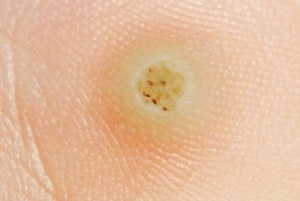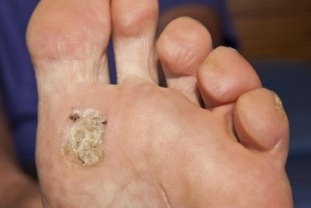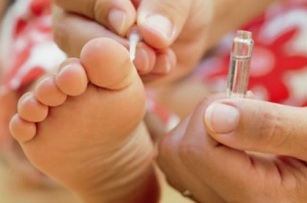
If a hard, rough papule with a rough top appears on the sole of the foot, this is a plantar wart or callus. The differences are significant, especially in the origin and method of treatment. Warts grow like sharp thorns on the inner layer of the skin of the feet, causing intense pain. Doctors recommend removing this skin swelling if it is damaged by the shoe and becomes inflamed.
The appearance of growths on the soles of the feet
The main part of common warts on the feet is ingrown, deep into the dermis. The reason is that from the outside the tumor is pinched by a hard surface: shoes, the various layers on which we walk. New growth cells emerge from the soft tissue of the skin. In the photo of plantar warts, solid plaque or roller is visible from the outside. The surface of the formation does not have skin stripes, consisting of horny scales. Adjoining skin changes: become denser, covered with a layer of keratin.
What plantar warts look like:
- nodule or plaque that appears above the epidermis by 1–5 mm;
- round, oval or polygonal shape;
- is hard and rough to the touch;
- pink, yellow-white or grayish color;
- formation diameter from 1 to 20 mm;
- missing papillary pattern;
- well defined edges.
Warts on the feet are characterized by acute pain that interferes with walking, to temporary disability.

Build-up occurs in areas that are subjected to intense stress and perspiration. Typical localization of warts on the soles: heels, pads of the feet and toes. Formations that are painful and difficult to remove appear on the edge of the nail and under the nail plate. Inside all types of warts are blood vessels that feed living tissue, cells that multiply intensively. Small black dots are visible on the surface - blood clots in the capillaries; they may bleed when the stratum corneum is cut.
Plantar warts are most common in school-aged children. In about 30% of patients, such formations go away on their own within the first year. However, it is advisable to start treatment when the first symptoms appear, especially if the wart is painful, or there is a high risk of infection in the people nearby. Infection is also dangerous, when a group of formations appears in one area, individual papules combine to form mosaic plaques.
Warts - a manifestation of the papilloma virus
The skin on the feet is often damaged, compressed, and sweaty when wearing tight, uncomfortable shoes. If a thin-walled blister with clear fluid inside appears, then this is corn. Sometimes a layer of keratin forms on the surface, but even so, the distinctive skin line remains.
The appearance of warts on the soles of the feet is initially not visible or is considered callus formation. It is necessary to carefully look at the surface of the formation and pay attention to characteristic signs. This is severe keratinization, the absence of a skin line, pain when the surrounding skin is compressed. This is the result of active reproduction of the papilloma virus in living epithelial cells.
Causes of warts on feet:
- papilloma virus (HPV) infection;
- weakens local and general immune defenses;
- virus activation, penetration into epithelial cells;
- increases multiplication and rapid keratinization of infected cells.
HPV is transmitted through household and sexual contact. The infectious agent penetrates even through minor damage to the skin and mucous membranes: cracks, cuts, weeping.
Papilloma viruses of types 1, 2, 4, 27 and 57 mainly infect cells located on the skin of the feet. The type of plantar growth originating from the virus is classified as simple (ordinary, vulgar). According to the International Classification of Diseases, they are both infectious and parasitic. Class ICD-10: "Viral infection characterized by lesions of the skin and mucous membranes. "
Simple warts are benign epithelial tumors. They initially did not pose a health hazard. Sometimes such growths undergo a malignant transformation into a cancerous tumor. This process is more often triggered by strains of HPV which are at high risk of developing cancer.
Foot wart treatment
After infection, the incubation period begins: the papilloma virus attacks the cells, "reformatting" their reproduction and development. Much more often, the infection becomes latent and in such a dormant state can occur throughout the life of the organism. Immunity in this case suppresses the papilloma virus, putting it into sleep mode without specific therapy.
Plantar warts may appear 3-10 years later or appear several weeks after infection, then disappear in the first year or within two years.
Not everyone is ready to wait, relying on the spontaneous healing and cleansing of the skin from growth. Many go to the doctor at the first sign of HPV infection. Dermatologists recommend using modern methods of removing warts, recommending ways of antiviral therapy, strengthening the immune system of the skin and the whole body.
If adequate therapeutic options are needed to determine the type of HPV, the doctor will prescribe several additional studies. A biopsy is performed to collect histological material, analysis is performed to determine antibodies to papilloma virus.

Maintenance options:
- Use of special medications for warts on the feet. There was dissolution and exfoliation of dead cells.
- Laser excision for a simple neoplasm with the formation of a scab, where healing takes place. The scale will disappear 7-10 days after the procedure.
- Cryodestruction with liquid nitrogen. Large warts are removed in several procedures. When exposed to low temperatures, bubbles will appear, like after burning.
- Electrocoagulation uses electrodes that deliver high-frequency currents to destroy pathological tissue. A painful procedure accompanied by a pungent odor of sunburn.
- Lifting operation.
- Drug injection.
At the beginning of the treatment, it is recommended to use a special plaster at home. This affordable remedy is used after softening the warts on the feet with warm water, removing them from the keratin layer using nail clippers and a pumice stone. Then the patch is applied. The average course of treatment lasted 1–3 months.
Prevention
Papilloma viruses can survive in the environment for a long time. It is important to keep your feet clean, do not go without shoes, especially in public changing rooms, bathrooms, in the swimming pool. It is necessary to use special sandals to protect the soles of the feet from contact with surfaces contaminated with other people's skin particles. Also, don't wear other people's socks and shoes.
Don't scratch the wart, otherwise similar growths will appear on other parts of the leg.
The papilloma virus is highly contagious. Disinfection of accessories for daily hygiene and medicinal applications. Socks and foot towels should be thoroughly washed with hot water, scissors, nail files, pumice stones should be disinfected. Make sure to wash your hands with soap and water after touching educational, various medical procedures.














































































